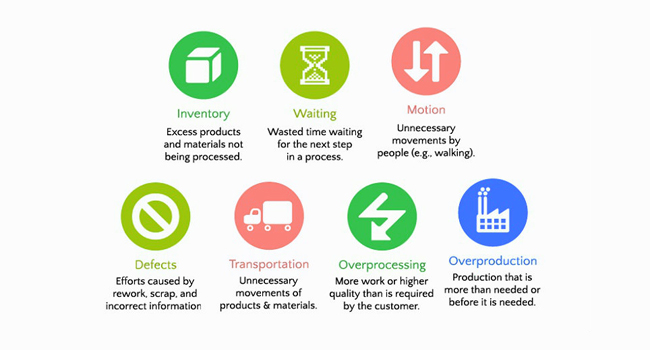
Seven Deadly Wastes
In lean manufacturing, waste is often broken down into seven areas, often called the “Seven Deadly Wastes”.
They are:
- Overproduction — Manufacturing a product before it is needed, for customers or product development purposes.
- Waiting — People, machinery or product waiting unproductively at any point in the production cycle or supply chain.
- Transportation — Unnecessary movement of finished products or components.
- Over Processing — Processing that exceeds customer needs or adds no value.
- Inventory — Excess storage of raw materials, components or finished goods.
- Motion — Unnecessary or overly complicated movement of people or information during the manufacturing process.
- Defects — Errors that require products to be reworked or scrapped.
Manufacturing operations must scour their processes to identify areas that produce waste. These areas can be obvious, such as 50,000 square feet of leased space to store packaging materials, or much less obvious, such as improper filtration equipment that increases the cost and treatment of fresh water and wastewater.
The challenge of waste reduction is identifying and taking action on all waste areas. To make this happen, manufacturers must make waste reduction a high priority and create awareness companywide. This can be accomplished by taking the following steps:
- Conduct regular, systematic waste reduction audits to identify all potential areas of waste reduction.
- Document audit results in detail. Set priorities for addressing each area of waste and quantify projected savings as accurately as possible.
- Assign responsibility for correcting problem areas, giving personnel authority and a clear chain of command to implement necessary changes.
- Involve personnel from all departments in this process, to ensure that correcting one problem doesn’t create new ones.
- Conduct regular, ongoing training and education in waste reduction to promote mindfulness and encourage personnel at all levels to identify areas of potential improvement.
- To compliment waste reduction efforts, look for ways to add value in the process. Identifying idle workers is one thing; giving them something valuable to do with the time makes waste reduction initiatives pay off exponentially.
- Emphasize quality throughout every stage of the manufacturing process. This will not only reduce defects, but also encourage personnel to recognize inefficiencies in production, waiting time, processing and motion and inventory management.
- Publicize waste reduction improvements. This increases awareness, improves morale by building confidence that progress is being made, and demonstrates the company’s commitment to waste reduction.
- Upgrade information technology systems, if necessary, in order to extract the data necessary to evaluate waste reduction performance and support an efficient process for manufacturing, procurement and inventory control.
- Simplify information technology systems, if needed, to eliminate excessive, unproductive work and analysis.
- Review vendors regularly to seek new ways of managing inventory and procurement. Common areas of improvement include just-in-time (JIT) ordering, Electronic Data Interchange (EDI) procurement systems and vendor-managed inventory programs.
- Seek new vendors in closer proximity to the manufacturing facility.
- Audit vendors regularly to ensure they have the proper systems in place to deliver zero-defect materials and services as efficiently as possible.
- Bring in outside observers to review processes from top to bottom. All organizations are vulnerable to “inside-the-box” tunnel vision; an outside assessment from a customer, vendor, stakeholder, peer or consultant can produce insights and suggestions that, while high impact, are virtually invisible to people within the organization.
In the ongoing effort to maintain low cost, high quality and profitable operations, manufacturers should view waste reduction as the low-hanging fruit. Unlike performance factors such as global economic conditions, innovation and consumer preference — waste management is very much within a manufacturer’s control. And given the volatility of economic conditions, the rapid evolution of technological innovation and the notoriously unpredictable nature of consumer preference, managing waste is clearly an area of focus no manufacturer can afford to ignore.
Author Bio:
Amber Carpenter is the Product Specialist at Commercial Industrial Supply, a leading online supplier of Eaton filtration products for a manufacturing facilities industrial filtration needs. Amber has a strong understanding of how to solve customer problems based on specific product needs.
